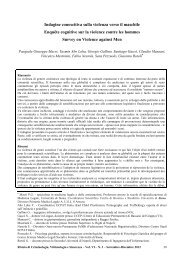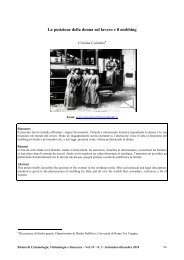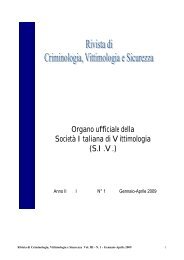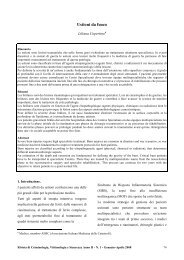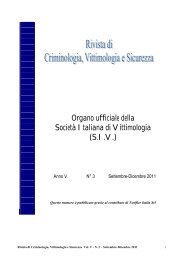Anno 2, Numero 3, Settembre-Dicembre 2008 - Vittimologia
Anno 2, Numero 3, Settembre-Dicembre 2008 - Vittimologia
Anno 2, Numero 3, Settembre-Dicembre 2008 - Vittimologia
You also want an ePaper? Increase the reach of your titles
YUMPU automatically turns print PDFs into web optimized ePapers that Google loves.
2.2. Private services.<br />
1. Associazione Familiari Vittime Della<br />
Strage 2 Agosto 1980 (The Association for<br />
victims of terrorism);<br />
2. Associazione Familiari Vittime Uno<br />
Bianca (The Association for the victims of “The<br />
White Fiat Uno” – armed attacks in Italy in the<br />
90’s where the perpetrators used a White Fiat<br />
Uno);<br />
3. Associazione Prima contro il mobbing e<br />
lo stress psicosociale (The First Association<br />
against physical and psychological bullying);<br />
4. Casa delle Donne per non subire violenza<br />
(Women’s refuge for victims of domestic<br />
violence);<br />
5. Codici Onlus: contro l’usura e il racket<br />
(for victims of organised crime)<br />
6. Gruppo giustizia UDI (Women’s refuge<br />
for victims of domestic violence);<br />
7. Il Pettirosso: per il recupero della<br />
tossicodipendenza (drug rehabilitation centre);<br />
8. MIT, movimento italiano transessuali:<br />
contro la stigmatizzazione della diversità<br />
(Movement for Italian Transexuals: against the<br />
stigmatisation of marginal groups).<br />
For example, with the Casa delle Donne, they deal<br />
with domestic violence against women.<br />
The main difference between the public and<br />
private sectors is that whereas the staff in the<br />
public bodies are full-time paid professionals, in<br />
the private sector most of the staff are voluntary.<br />
Bibliography.<br />
• Balloni A., Bisi R. (a cura di) Lavoro e<br />
impresa per la lotta contro la criminalità: ricerca<br />
promossa dal Comitato regionale Giovani<br />
The workers in the centres were asked a variety of<br />
work related questions, for example, the various<br />
difficulties they faced, the types of treatment<br />
given, public and private partnerships, the<br />
definition of victim, etc.<br />
3. Conclusions.<br />
From their responses the following problem areas<br />
emerged:<br />
1. The lack of financial support;<br />
2. The inconsistent (porous) network;<br />
3. The lack of training for staff;<br />
4. Lack of risk management for the victims<br />
of crime.<br />
The unsettled question is about the definition of<br />
the victim, in fact, most of the subjects<br />
interviewed stated that the present ‘legal’<br />
definition of a victim of crime – (that is) i.e. “a<br />
victim of physical abuse” – is inadequate as it<br />
doesn’t take into consideration any psychological<br />
abuse which is also very important.<br />
There is not only no formal support for the victim<br />
(on a psychological level) but also none on a one<br />
to one level. The professionals dealing with the<br />
victim’s case do not have adequate professional<br />
training to help the victim come to terms with the<br />
psychological after effects of the crime.<br />
dell’industria della Confindustria Emilia-<br />
Romagna, Bologna, CLUEB, 1994.<br />
• Bisi R.(a cura di), <strong>Vittimologia</strong>, Franco<br />
Angeli, Milano, 2004;<br />
Rivista di Criminologia, <strong>Vittimologia</strong> e Sicurezza Vol. II - N. 3 - <strong>Settembre</strong>-<strong>Dicembre</strong> <strong>2008</strong> 76



